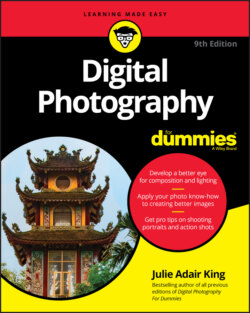Читать книгу Digital Photography For Dummies - King Julie Adair, Julie Adair King - Страница 12
Choosing the Right Level of Camera
ОглавлениеDigital cameras come in a variety of sizes, styles, and even colors. Later sections in this chapter provide details to help you narrow your shopping list to a few contenders. But first, it helps to consider whether you’re best suited to a basic, intermediate, or advanced camera. Here’s how I define these categories:
Basic models: I use this term to describe entry-level cameras that offer few (or no) controls over exposure, focus, and so on. Smartphone and tablet cameras also fall into this category.A basic model is perfect if you're a casual photographer. That is, you enjoy taking selfies, shooting pictures of the gang at special occasions, and sharing photos of your kids or pets online. Or perhaps your work requires photographic documentation of some sort. For example, an insurance adjuster needs to include pictures of hail damage in order to process a claim. Either way, you want your pictures to be as good as possible, but you aren't interested in taking classes or otherwise learning advanced photography techniques.
Intermediate models: By intermediate, I mean a camera that offers both automatic and manual picture-taking controls. Go this route if you want to explore photography but don't know much about the topic yet. That way, you can rely on automatic shooting modes while you're learning, and gradually step up to manual options. You can find a wide range of models in this category, some of which provide only a handful of advanced options and others that offer nearly pro-level controls.
Advanced models: Cameras in this category are designed for photographers who want more sophisticated controls than intermediate cameras provide. For example, with some high-end cameras, you can use the built-in flash to trigger off-camera flash units, providing lighting flexibility that's often required for professional portrait photography. You also get substantially more ways to customize your camera, from tweaking autofocus performance to changing the function of camera buttons. Often not included on cameras in this category are automatic shooting modes or other make-it-easy features that you find on basic and intermediate cameras. Some models don’t even offer a built-in flash, requiring you to buy a separate flash unit. This leads me to offer the following caution: No matter how much the camera salesperson (or your professional photographer friend) tries to convince you to “start at the top,” don't buy an advanced camera until you master an intermediate model. The added complexity will likely overwhelm you, not to mention make a larger dent in your bank account. Step up to this level only if you start doing projects that require features not found on your intermediate-level model.
Of course, you may have multiple-photography personality, as I do, and need more than one option at your disposal. For example, for wildlife and travel photography, I lug around the large, advanced body and telephoto lens shown on the far left of Figure 1-1. (This type of camera is called a dSLR, which stands for digital Single Lens Reflex; see the section “Interchangeable-lens cameras,” later in this chapter, for details.) I get awesome shots with this setup, but it’s too large to carry all the time. For casual shots on the go, I use my smartphone — it's great for snapping scenes that catch my eye while I'm walking the dog, for example. As a point of reference, the phone in the figure measures about 5½ inches tall and about 3 inches wide.
FIGURE 1-1: Each of these cameras plays a different role in my photography life.
Then there are times when I don’t need all the bells and whistles of my “big rig” but want more features than my phone provides – a zoom lens, for example, or, if I’m shooting outdoors, a viewfinder that makes framing my shots easier than relying on the phone’s screen, which can wash out in the sun. For those outings, I pick up one of the two smaller models in the figure, both of which sport intermediate-level controls. The one in the middle of the picture is a fixed-lens model (meaning you can’t swap out lenses), but it has a pretty long-range zoom lens and fits easily into my purse. The other dSLR model (the far-right camera) isn’t really purse material, but it works with the same lenses and flash I can attach to my advanced model, and the body is considerably smaller and lighter than my other dSLR.
All of which is to say that it's okay to put more than one camera on your next birthday wish list. In fact, I highly recommend it. But you still need to make sure that each model you buy suits the type of photography you want to do.
To get you started down that path, the next sections pose questions that I ask anyone who comes to me for buying advice. Your answers will guide you closer to the perfect camera(s) for you.
